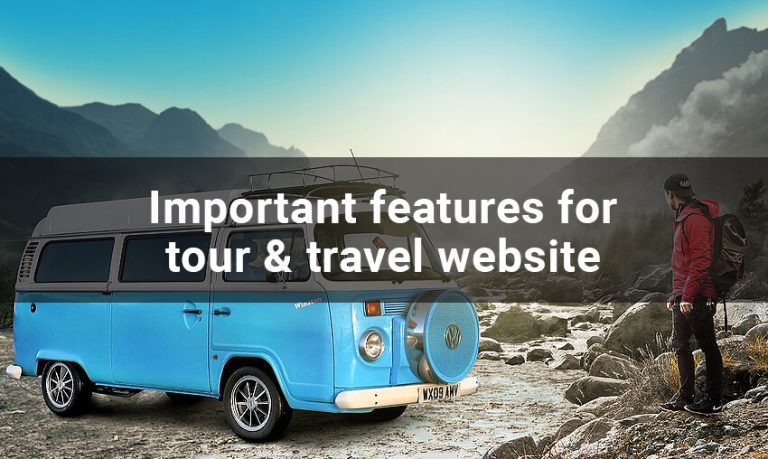Designing a travel website is more than including pretty images of exotic destinations and hoping that your customers complete their booking. It’s a highly accurate science, and here’s how you can get it right.
Gone are the days when travelers used to be satisfied with the services offered by offline travel agents and group tours. In today’s era of millennials and digital natives, travelers are highly choosy. They want something out of the ordinary. They are looking for highly curated travel experiences that are perfectly tailored to suit their personalities.
According to travel statistics by Google for 2018,
- 36% of travelers would pay more for tailored information.
- 57% of travelers feel that travel websites should customize information based on their past bookings and personal preferences.
- 1 in 3 travelers uses digital assistants to research and book their travel.
The Change in Preferences and Tastes of Today’s Travelers
People’s travel preferences have changed significantly in recent years. The earlier generations, like the Baby Boomers and Gen Xers, didn’t prioritize travel. And, if at all, they traveled, it was to historical and religious sites, rich in culture and heritage. The earlier generations considered travel as something to do once they retire.
Fast forward to today. For the younger generations – the millennials and the digital natives, travel is part and parcel of their life. The number of people going on impulse trips has increased by a massive 150% in the last couple of years.

See How Our Experts Can Drive More Traffic to Your Website!
SEO: Boost your rankings and drive more organic traffic today!
Website Design/Development: Create a stunning website that converts visitors into customers.
Paid Media: Reach the right audience at the right time with expertly managed paid media.
Solo travel has increased dramatically. According to a survey conducted by Adventure Travel, nearly 80% of millennial travelers are willing to travel solo. Additionally, the number of people who are willing to spend more on unique and customized travel experiences has increased significantly.
All this is good news for travel and tourism website owners. If you can provide travelers with the right information at the right time, tailored to meet their specific needs, then you are more likely to convert it into a sale.
Every single component on your travel website should aim to meet this goal – provide users with the right information at the right time.
Now, that’s easier said than done. How do you ensure that your travel website is loaded with the right features? How to nail the user interface and user experience, so that you can make a sale? While there is no magic formula that works for all, here are some general best practices that will help you build the perfect travel website that appeals to and connects with your target audience.
Let’s get started.
1. A Responsive, Mobile Friendly Design
It’s 2019, and if you don’t have a website that is mobile-friendly or mobile-first, then you are missing out on a large chunk of your potential sales. According to a Mobile Travel Trends 2018 report published by HubSpot, 61% of users are unlikely to return to a site, if they had trouble loading it on their mobile device. 40% of users are likely to jump ship to a competitor’s site if the mobile site of their preferred brand takes too long to load.
These numbers are too big to ignore. With these stats in mind, you have to start working on building a mobile-friendly, and responsive travel website, which delivers your users an optimized booking experience on all devices.
2. Clean, Easy-to-Use, and User-friendly Search Forms
Search is the heart of all travel websites. Most travelers who research travel destinations online do not have any specific place in mind. Instead, they are scouting for all the options that catch their fancy. So, a dynamic search engine is one of the top, must-have travel website features, and you need to ensure that you get it right.
If you strip it down to the basics, then the travel search is simple. It should answer the questions – “when” and “where.” Additionally, you can also enhance the search feature by including other filters that your target audience is likely to use.
For instance, if you are a tour operator catering to adventurous travelers, then it’s a good idea to include “type of vacation,” as a field in the search form. Using this filter, travelers can search for specific destinations that are suitable for water sports, hikes, adventure activities, etc.
Here are some good practices from a leading travel website design company to keep in mind while designing the search feature on your website:
- Geo Location – Automatically identify the starting point of your customers and their local currency to provide an enhanced user experience. This is a huge time-saver as your website users need not type in their home location every time they are researching travel destinations.
- Advanced Search – Instead of complicating the search button with plenty of fields, get your WordPress development company to design a separate advanced search button to break down the information into several parts. The basic search button will just have the destination and travel dates and number of travelers. While the advanced search button can use other filters like type of travel, accommodation style, etc.
3. Clean Yet Complete Search Results
Next, to the search button, the search results are one of the top features of a tour and travel website. If your search results are cluttered and messy, it can negatively impact the whole user experience. The search results displayed on your travel and tour website should be clean and uncluttered. At the same time, it must provide all the information required by travelers so that they can quickly compare results and pick the right option that works for them.
This is why you need to hire a WordPress expert to design your travel website. An experienced web designer will be able to analyze user data to highlight the features that are important to your users. For instance, most travelers consider the distance of a hotel from the city center/subway as one of the key criteria while comparing hotels. Another essential feature is the availability of free in-room Wi-Fi and breakfast at the hotel.
Get your website designer to highlight these features in your search results. Here are some of the best practices for designing search results:
- Sticky Search Bar – The search bar should always be at the top of the screen so that users can quickly alter the search criteria to refine results.
- Photo Previews – Most travelers prefer to view photos of the hotel/destination they are searching for, without having to leave the search results page.
- Personalization – Make use of cookies to show results that are similar to previous bookings made by the user. Alternatively, you can also use machine learning tools to make the right customized recommendations to each user, based on their demographic data and preferences.
4. Be Transparent
According to a survey by SaleCycle, nearly 53% of users abandon their travel searches when they are presented with the total price, inclusive of taxes and other charges at the last stage of their search. If you want to reduce shopping cart abandonment rates, then you need to disclose all the fees and miscellaneous charges at every step of the way.
Here are a few ways in which you can make your travel website transparent and win the trust and loyalty of your potential customers:
- Mention clearly what’s included and what’s not included – If the hotelier offers free Wi-Fi and/or breakfast mention it clearly. Alternatively, if the hotelier charges a resort fee, tourist taxes or other additional fees then make sure to disclose this early on. This helps to develop a clear line of communication with your users.
- Be Comprehensive and provide Complete Information – If the booking fee is refundable until a particular date and not refundable after that, make sure to mention this clearly, so that your customers know what they are getting into.
Simply put, be transparent will all kinds of extra charges and don’t spring any surprise fees on the user at the time of checking out.
5. Include Social Proof and Third-Party Reviews
According to a survey by TripAdvisor, nearly 96% of travelers read reviews before they complete a travel booking. Reviews are the bread and butter of the travel and tourism industry. Hence, it’s essential that you include unbiased user reviews on your travel website.
Here are a few suggestions to include reviews and testimonials on your site:
- Include trusted Third-Party Reviews – TripAdvisor, Yelp are some of the trusted travel review websites. Get your ecommerce website design services company to integrate third-party reviews on your website so that your users get access to genuine reviews.
- Include Video – To make your travel website stand out from your competitors, you can include video reviews on your site. To get more videos up, provide small freebies to users – like extra loyalty points, and free breakfast on their next stay, as an incentive for them to submit video reviews.
Your Website Matters More than you Think
Running a travel business is highly competitive, and your website is your calling card. It acts as the first touch point for all your users. Hence, it’s essential that you make the best first impression. Apart from the five design points highlighted above, you need to focus on improving the overall user experience by including high-quality images, reducing the loading time of your website, adopting a mobile-first approach, and more.
Building a travel website that offers high conversion rates is not a one-time process. You have to repeatedly work on it and use various A/B testing to optimize the site. Additionally, you have to ensure that you provide your users with a consistent UX/UI so that your site remains familiar and easy to use.
As you can see, designing a travel website is quite complicated, and there’s no room for error. Hence, it’s highly recommended that you hire the services of an expert travel website design company to help you hit your conversion goals and stay ahead of your competitors.






